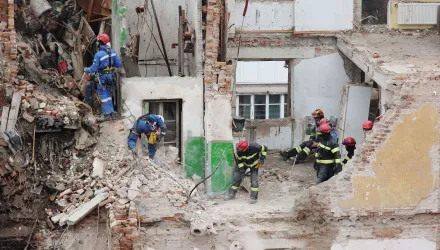Would Russia be capable of mounting an invasion into a NATO country? If so, would it exercise that capability, and when?1 Western officials and experts provided no shortage of affirmative answers to these questions even before the launch of Russia’s full-blown invasion into Ukraine on Feb. 24, 2022, to say less of the subsequent period. Understandably, many (but not all) of these forecasters have made the materialization of their predictions contingent on Russian-Ukrainian hostilities ending or pausing in a way that allows Russia to generate sufficient offensive capabilities.2 To hear Inspector General of the Bundeswehr Carsten Breuer put it, Russia will be militarily ready to attack NATO countries by 2029, at the earliest. "By then, based on our analysis, Russia (will have) reconstituted its own forces to a degree that an attack against NATO soil could be possible," Lt. Gen. Breuer reportedly predicted during a visit to Poland in April 2024. Then-secretary-general of NATO Jens Stoltenberg also said that a Russian attack on a NATO country or countries as soon as 2029 was something he was concerned about. By that year, Russia would not only be ready to attack, but would also be willing to do so, according to Stoltenberg’s February 2024 remarks. Some of the more recent post-February 2022 forecasts, which I have found and catalogued in Table 1 below, assume it would take Russia longer to become ready for an attack. For instance, Germany’s Federal Intelligence Service in March warned that Russia could be fully ready for a "large-scale conventional war" by 2030.
Of the predictions for when Russia will acquire the capability and/or intent to attack a NATO country, which I have visualized in Figure 1 below, the most frequently forecast years for when Russia would be ready to attack a NATO country (capability) are:
- 2030 (mentioned or implied 13 times),
- 2029 (mentioned or implied 12 times) and
- 2028 (mentioned or implied 10 times).
As for when Russia might intend to attack a NATO country, the most frequently forecast years are 2027 and 2028 (each mentioned or implied 5 times).
Whether and when Russia will be ready for new combat in Europe will depend on what kind of war it would want to wage once the conflict with Ukraine is over or frozen. As stated above, Russia will be prepared to wage a large-scale war by 2030, according to Germany’s Federal Intelligence Service. According to Baltic officials cited in the Wall Street Journal in April 2025, the Russian armed forces would be ready for a large-scale war against NATO in seven to 10 years after the end of Russia-Ukraine hostilities. As for a limited operation, Russia will be ready to conduct one against the Baltic states3 in two to three years after the end of Russia-Ukraine hostilities, according to a summary of these Baltic officials’ views that the Carnegie Endowment’s Michael Kofman shared with WSJ.
However, not everyone thinks Russia would need to first be done with the war against Ukraine to attack a NATO country. For instance, ex-Foreign Minister of Ukraine Dmytro Kuleba believes “Moscow is capable of opening a new front while still battling Kyiv.”
Not everyone publicly agrees that Russia would attack NATO, though. Last year saw John Foreman, the former British defense attaché in Moscow, pen an article entitled “Russia will not attack NATO” in the Spectator.
His retired colleague, Britain’s current chief of the defense staff, Adm. Tony Radakin, has also stated that Russia will not attack NATO, according to an article in the Financial Times earlier this year. Public skeptics include not only U.S. President Donald Trump’s ‘envoy for everything,’ Steve Witkoff,4 but also, predictably, Russia’s Vladimir Putin5 and his press secretary Dmitry Peskov. The problem with the Kremlin’s assurances that NATO will not be a target for a Russian military attack, however, is that the Russian leadership said the same thing about Ukraine before Feb. 24, 2022. In fact, just days before the Feb. 24, 2022, invasion, then-Russian Defense Minister Sergei Shoigu reportedly denied, during a meeting with his U.K. counterpart, that Russia was planning to invade Ukraine.
No matter what assurances Russian leaders might offer about not invading NATO countries, it is the job of the military-political leadership of these countries to prepare for the worst-case scenario, even if it seems unlikely. Such preparations are costly, compelling the leaders of these countries to divert funds from, among other things, social programs, or to increase taxes, which would require the support of the general public. The repeated public warnings of a Russian attack on NATO are clearly meant to build such support.
Table 1: Estimates by Western officials and experts of when Putin’s Russia could acquire the capability to attack a Western neighbor, as well as under what conditions it would do so.
| Who made the forecast | When the attack could occur | Under what conditions (if given) |
| Lithuanian Gen. Valdemaras Rupšys (Politico, 01.25.24) | Russia won’t attack a NATO country (countries) in 2025–2026: “This year, next year, the possibility or the probability of a war between Russia and NATO is very low, extremely low.” | Conditions might change, but currently Russian forces of the country's western military district are fully engaged in Ukraine, posing no immediate threat. |
| Estonia's Foreign Intelligence Service chief Kaupo Rosin (Reuters, 02.13.24) |
Russia would be able to attack a NATO country (countries) in 2025–2034 (within the next 10 years): "Russia has chosen a path which is a long-term confrontation… and the Kremlin is probably anticipating a possible conflict with NATO within the next decade or so," Rosin told reporters at the release of Estonia's national security threats report in 2024.
|
If Russia no longer needs to keep troops in Ukraine and if NATO countries fail to match Russia’s military build-up along its Western frontiers.
|
| NATO military committee chief Rob Bauer (Daily Mail, 01.18.24, RFE/RL, 01.19.24) | Russia would be able to attack a NATO country (countries) in 2025–2044: Bauer said civilians in the NATO countries of Europe must be ready for a conflict in the next 20 years. |
After (and if) Ukraine is defeated by Russia.
|
|
Jacek Siewiera, head of the Polish National Security Bureau (Nasz Dziennik, 12.02.23)
|
Russia would be able to attack a NATO country (countries) in 2024–2026: “If we want to avoid war, NATO countries located on the eastern flank should adopt a shorter, three-year time horizon to prepare for confrontation,” according to Siewiera.
|
If NATO doesn’t properly prepare for a confrontation with Russia in 2023–2026. |
| Western intelligence services (Bloomberg, 02.14.24) | Russia would be able to attack a NATO country (countries) in 2027–2029: “Western intelligence assessments are suggesting that the Kremlin could be in a position to target a NATO member within the much shorter span of three to five years.” | After the first phase of Putin’s imperial ambitions in the form of his war against Ukraine is completed, according to Bloomberg. |
| Danish Defense Minister Troels Lund Poulsen (Jyllands-Posten/Reuters, 02.09.24, FT, 02.14.24) | Russia might attack a NATO country in 2027–2029: "It cannot be ruled out that within a three- to five-year period, Russia will test Article 5 and NATO's solidarity. That was not NATO's assessment in 2023. This is new knowledge that is coming to the fore now.” | |
|
NATO secretary-general Jens Stoltenberg (NYT, 02.18.24)
|
Russia might attack a NATO country in 2027–2029: Jens Stoltenberg, the secretary-general of NATO, together with a series of defense and intelligence officials, referred repeatedly to recent intelligence conclusions that in three to five years Putin might attempt to test NATO’s credibility by attacking one of the countries on Russia’s borders, most probably a small Baltic nation.
|
|
| NATO military committee chief Rob Bauer (Economist, 02.18.24) | Russia might attack a NATO country in 2027–2031: Three to seven years is the range that “a lot of people talk about,” Bauer said. |
After (and if) Ukraine is defeated by Russia.
|
| Ukrainian President Volodymyr Zelenskyy (LB.ua, 11.05.23) | Russia would be able to attack a NATO country (countries) in 2023– 2028: Zelenskyy warned in that if Russia isn’t defeated in Ukraine, it could be ready to attack the Baltic countries within five years. | If Russia isn’t defeated in Ukraine. |
| IISS (May 2025) | Russia would be able to attack a NATO country (countries) in 2027. | “Russia could be in a position to pose a significant military challenge to NATO allies, particularly the Baltic states, as early as 2027. By then, Russia’s ground forces could mirror its February 2022 active equipment holdings through a combination of refurbishment and the production of new systems.” |
| Inspector General of the Bundeswehr Carsten Breuer (Reuters, 04.18.24) |
Russia would be able to attack a NATO country (countries) in 2029–2032: Russia could be ready militarily to attack NATO countries in five to eight years' time if it chose to do so, Germany's top military official said, once it has rebuilt its forces hit by the impact of the Ukraine war. "We see that Russia is producing a lot of war-fighting material and it is not putting all of this material to the frontline in Ukraine... so in 2029 we have to be ready," Breuer said. "What we see is a threat in five to eight years."
|
Once Russia has rebuilt its forces hit by the impact of the Ukraine war. |
| Germany's Defense Minister Boris Pistorius (Bloomberg, 02.19.24, Politico, 01.19.24, Der Tagesspiegel, 01.19.24) | Russia would be able to attack a NATO country (countries) in 2029–2032: Pistorius said the alliance should prepare for a Russian attack on a NATO country within five to eight years. “I can’t predict if and when an attack on NATO territory might occur,” Pistorius told Bloomberg in an interview. “But it could happen in five to eight years.” | |
| Constitution Protection Bureau of Latvia (NY Post, 02.17.25) | Russia would be able to attack a NATO country (countries) in 2025–2030. | A pause in the Ukraine war will allow Russia to rebuild its forces in preparation for an attack on NATO and European nations within five years, the bureau said. |
|
U.S. government (Economist, 05.08.25)
|
Russia would be able to attack a NATO country (countries) in 2025–2035: America talks of Russia reconstituting its army during the next decade.
|
|
| Norwegian intelligence (Economist, 05.08.25) |
Russia would be able to attack a NATO country (countries) in 2030–2035: Norwegian intelligence reckons [Russia would be ready to attack in] 5–10 years “at the earliest.”
|
|
| Ukrainian government (Economist, 05.08.25) |
Russia would be able to attack a NATO country (countries) in 2030–2032: Ukraine’s estimates suggest [Russia would be ready to attack in] five to seven years.
|
|
| German intelligence (Economist, 05.08.25) |
Russia would be able to attack a NATO country (countries) in 2030–2033: Germany’s estimate is that Russia would be ready to attack within five to eight years.
|
|
| Estonian government (Economist, 05.08.25) | Russia would be able to attack a NATO country (countries) in 2028-2030: Estonia’s estimate is that Russia would be ready to attack within three to five years. | |
| Danish Defense Intelligence Service (DDIS) (Newsweek, 05.21.25) | Russia would be able to attack a NATO country (countries) in 2025-2030: The Danish Defense Intelligence Service (DDIS) warned that Russia could be ready to wage a "large-scale war" in Europe within the next five years. While "there is currently no threat of a regular military attack on the Kingdom," it is likely that the "military threat from Russia will increase over the coming years," it said. | |
|
Germany's Federal Intelligence Service (BND) (Newsweek, 05.21.25)
|
Russia might attack a NATO country (countries) by 2030: Russia could be fully ready for a "large-scale conventional war" by 2030. | "Russia sees itself in a systemic conflict with the West and is prepared to implement its imperialistic goals through military force, even beyond Ukraine," the report said. |
| Baltic officials (WSJ, 04.27.25) | Russia might attack a NATO country (countries) in 2027-2035: “If you ask how soon the Russian military could conduct a limited operation against Baltic states, the answer could be quite soon,” said Michael Kofman, senior fellow in the Russia and Eurasia Program at the Carnegie Endowment for International Peace, a Washington think tank. Baltic officials, he said, are “looking at a two to three year timeline after the war. If the benchmark is a large-scale war, presumably with NATO, the timeline could be more like seven to ten years, depending on the scenario.” | |
| National Security Bureau of Poland (Kyiv Independent, 05.21.25) | Russia might attack a NATO country (countries) in 2025-2028: "If we want to avoid war, NATO countries on the eastern flank should adopt a shorter, three-year time period to prepare for confrontation," said Jacek Siewiera who heads the National Security Bureau of Poland. Siewiera suggested that Russia might target a NATO alliance member in Eastern Europe, including countries such as Poland, Estonia, Romania and Lithuania. | |
| Estonia’s military intelligence (VS Square, 09.15.23) | Russia would be able to attack a NATO country (countries) in 2029: If the war were to stop today, it would take Russia between three to five years to restore its military might and capabilities to the level they would need to strike the next neighboring country, says Col. Margo Grosberg, outgoing chief of Estonia’s military intelligence. According to this calculation they’d be ready [to attack a neighbor again] in four years.” |
If the war is over in 2025.
|
| Danish Defense Intelligence Service (Politico 02.11.25) |
Russia would be able to attack a NATO country (countries) in 2025–2030: DDIS offers three scenarios that could occur if the Ukraine conflict stops or becomes frozen, working from the assumption that Russia does not have the capacity to wage war with multiple countries at the same time. Within six months, the update projects, Russia would be able to attack a NATO country (countries) to wage a local war with a bordering country, while within two years it could launch a regional war in the Baltic Sea region. In five years, meanwhile, it could launch a large-scale attack on Europe, provided the U.S. does not get involved.
|
If the war is over or frozen in 2025.
|
| Gen. Sir Richard Shirreff, former NATO Deputy Supreme Allied Commander Europe (Unheard, May 2025) | Russia would be able to attack a NATO country (countries) in 2028–2030: Sir Richard estimates that Putin may be ready in three to five years, depending upon the impact of casualties in Ukraine and how the Russian economy fares. What is clear is that Putin is not ready yet. He is “completely fixed on Ukraine and has no capacity for anything else” for the time being. |
Footnotes:
- This is an update of “Will Russia Attack NATO and, If So, When,” Russia Matters, 02.23.24.
- Some believe Russia is already well on its way to generating such offensive capabilities. “Despite extensive battlefield losses in Ukraine, the Russian military is reconstituting and growing at a faster rate than most analysts had anticipated. In fact, the Russian army, which has borne the brunt of combat, is today larger than it was at the beginning of the war—despite suffering an estimated 790,000 casualties,” according to SACEUR Christopher Cavoli’s recent estimate.
- Such a limited operation would “begin with a limited incursion into NATO territory at a perceived weak point—for example, in one or more of the Baltic states,” according to Fabian Hoffman’s FP commentary on what a Russia-NATO war could look like. “After the initial attack, Russia might declare that any attempt to retake the occupied area would trigger nuclear escalation,” Hoffman warns.
- Steve Witkoff, Donald Trump’s envoy for peace talks with Russia, when asked whether Russia intended to “march across Europe,” responded simply: “100% not,” according to a May 8, 2025, report by The Economist.
- Back in 2015, Putin said that “[O]nly an insane person and only in a dream can [one] imagine that Russia would suddenly attack NATO.” That said, Putin regularly adds disclaimers, such as in his September 2024 warning that Russia would be “at war” with the United States and its allies if they lifted restrictions on Ukraine's use of long-range Western weapons.
Simon Saradzhyan is the founding director of Russia Matters. Opinions expressed herein are solely those of the author. Photo by AP Photo/Sergei Grits.
Saradzhyan, Simon. “Would Russia Attack NATO and, If So, When?.” Russia Matters, June 5, 2025
The full text of this publication is available via Russia Matters.





